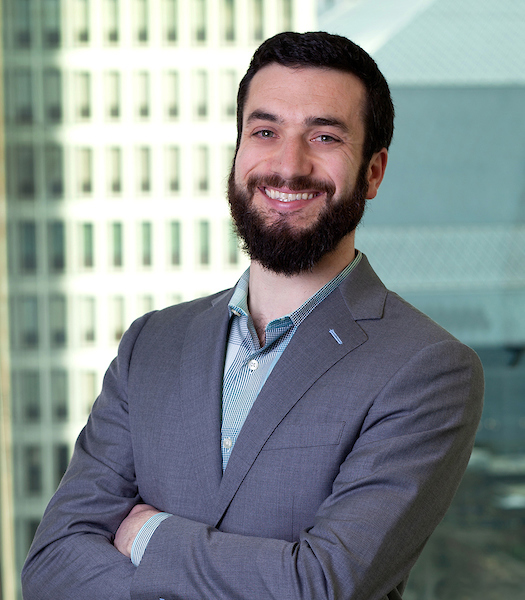Amazon HQ2: A Model of Sustainable Development and Decarbonization
Introduction:
The impact of the built environment on the climate has become increasingly evident, with buildings contributing nearly 40% of global CO2 emissions and consuming more energy than both the industrial and transportation sectors. Low-carbon solutions on large developments, however, can be challenging due to impracticality at scale, lack of proven effectiveness, regulatory constraints, and the need for substantial infrastructure investments for limited benefits.
As the urgency to address climate change grows, companies are recognizing the need to address these critical challenges, take bold action and implement sustainable solutions to mitigate their carbon footprint. One such company is our client, Amazon, which embarked on a visionary project to construct HQ2 in Arlington, VA with a commitment to run the development with zero operational carbon emissions.
In this case study, we explore Amazon’s ambitious sustainability efforts and the vital role Seneca Group played in guiding and implementing Amazon’s decarbonization strategies on HQ2. Their vision involved not only accommodating thousands of employees but also improving operational efficiency and promoting the preservation of the natural environment. In addition, Amazon aimed to inspire change across various industries, setting an example for sustainable development.
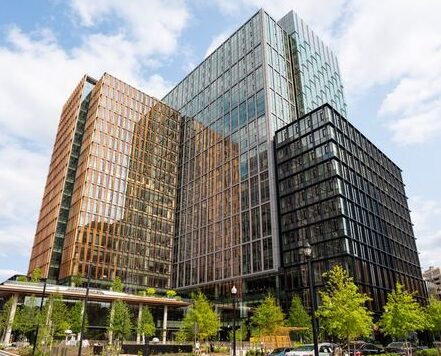
Key Actions Taken:
Seneca Group facilitated sustainable design and construction practices that aimed to drive change across industries and push the boundaries of what is achievable. Working closely with Amazon, we recommended and oversaw the implementation of various climate-friendly solutions for the 2.1 million square foot office development. These strategies included the use of low-carbon concrete, mass timber, electrified energy-efficient building systems, innovative water reuse methods, and the incorporation of green roofs, landscaped plazas, and a 2.5-acre public park.
Recognizing the significant contribution of concrete to global greenhouse gas emissions and knowing that concrete contributes the largest share of a project’s overall embodied carbon footprint, we prioritized addressing this issue in our sustainability strategy for HQ2. Our team evaluated and implemented the use of advanced, low-carbon concrete mix designs and incorporated CarbonCure (circleR), a technology supported by Amazon. This technology introduces recycled carbon dioxide into fresh concrete, effectively reducing its carbon footprint without compromising performance.
Additionally, to support the client’s vision, we looked for opportunities to leverage alternative sustainable materials within the project. We guided the design and construction of a mass timber structure in the Meeting Center at HQ2. This highly visible structure features ten 70-foot-long cross-laminated timber beams for structural support.
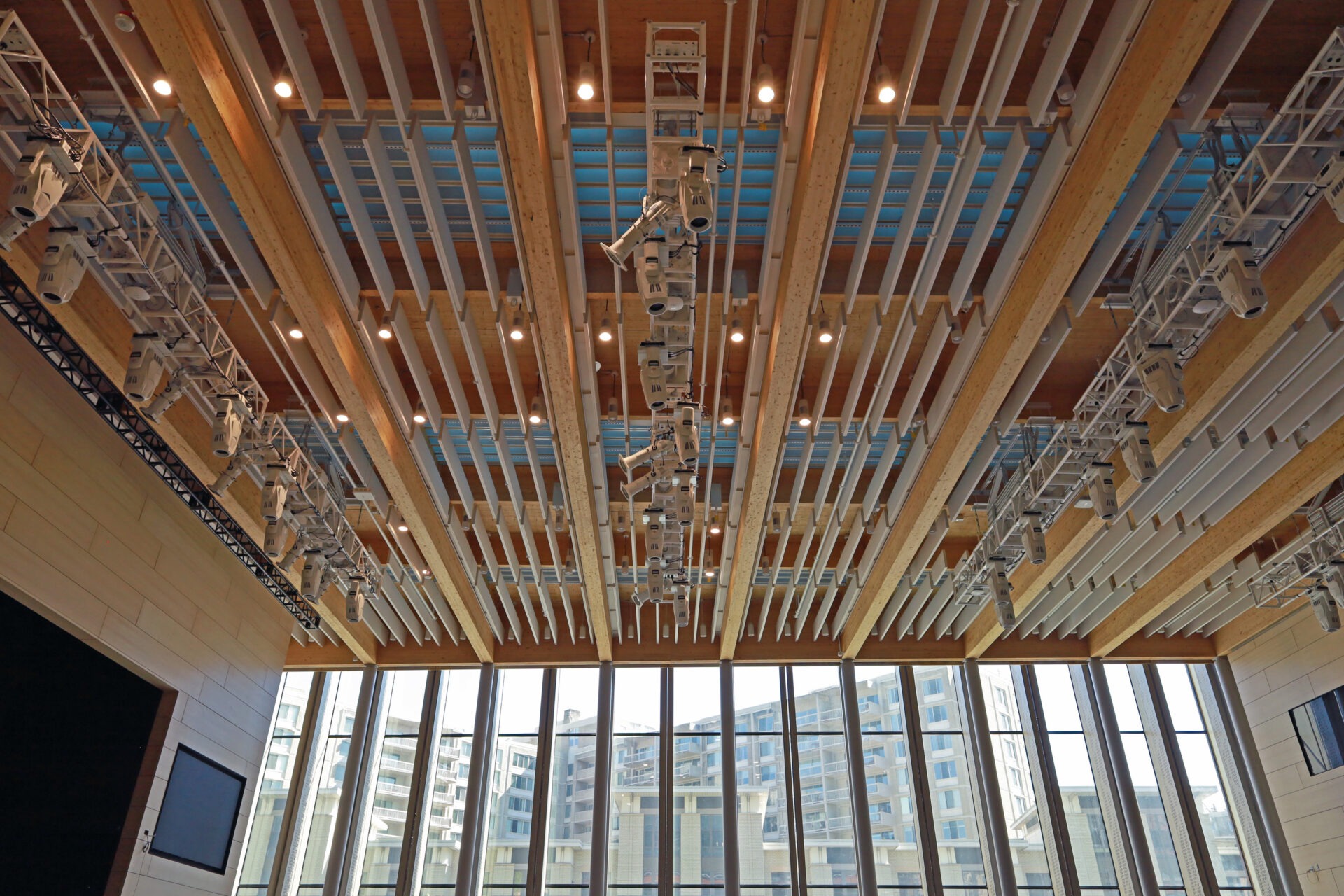
To help deliver a building that would operate with zero carbon emissions, we advised on the adoption of fully electric HVAC systems, water heaters, and food service equipment that are powered by renewable energy sourced from a solar farm in Virginia. We also helped facilitate complete electrification of the retail spaces, including restaurant and other food service tenants.

To address water usage, we guided recommendations of technology to reclaim and recycle rainwater and greywater for cooling towers, landscape irrigation, and flushing fixtures. Furthermore, we worked with our client to select low-flow urinals, toilets, and lavatories that exceed the Environmental Protection Agency’s requirements by nearly one-third, contributing to water conservation efforts.
As part of efforts to connect building occupants to nature, Seneca Group ensured the project incorporated two acres (90,000 square feet) of landscaped green roofs with native plantings. These green spaces serve multiple purposes, including providing outdoor meeting areas, dog runs, and even an urban farm.
Seneca Group oversaw the landscaping design, focusing on incorporating native and adaptive plantings that suit the climate of Arlington while attracting local pollinator species. Moreover, the soil was engineered to retain water and promote root growth, and smart, low-flow irrigation systems were optimized to minimize water consumption, aligning with reclaimed water management practices.
Additional efforts were made to ensure sustainable construction practices. Seneca Group engaged with contractors who prioritized sustainability, implementing best practices around efficient use of construction materials, increasing use of prefabrication methods, and focusing efforts to reduce the project’s overall construction waste.
Benefits to Climate and Community
Amazon’s HQ2 is designed to achieve a 24% reduction in overall energy consumption relative to a comparable office building. This energy savings amounts to the equivalent electricity needed to power 572 homes in the United States every year. Eliminating the use of fossil fuels means the project can be powered entirely by renewable energy, and by facilitating the retailers’ electrification, local business owners will reduce their carbon footprint and accelerate industry knowledge.
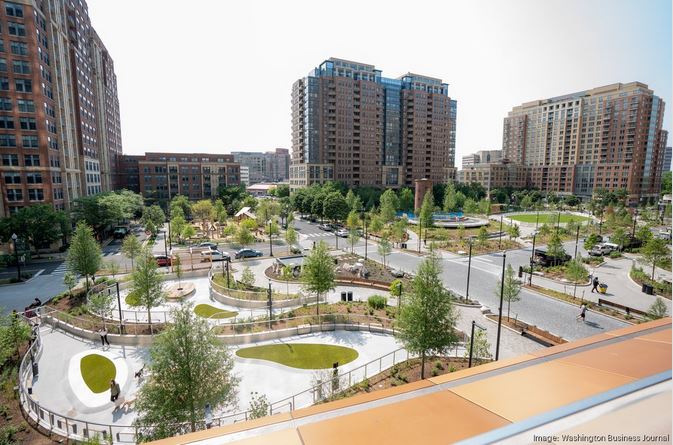
The project achieved a 20% reduction in the carbon footprint of the concrete structure compared to the industry baseline. This reduction translates to over 14,700 metric tons of carbon dioxide, equivalent to taking more than 3,200 cars off the road in the US for an entire year. The incorporation of structural timber in the building design supports sustainability goals and furthers industry knowledge. Wood absorbs carbon dioxide as it grows and continues to store that carbon throughout its lifecycle as a building material. By using structural timber, HQ2 provided an opportunity to expand industry knowledge and promote the wider adoption of this sustainable material in the region.
Through the capture and reuse of rainwater, shower water, and HVAC condensate, the building is expected to achieve over 50% water savings below the requirements of the building code. These systems are designed to recycle 7.5 million gallons of water per year, more than enough water to fill the reflecting pool at the Lincoln Memorial.
The incorporation of recycled water systems not only conserves natural resources but also enhances the building’s resilience to future climate impacts. By reducing reliance on potable water sources, HQ2 contributes to long-term water sustainability.
In addition to supporting occupant health and wellness, the green roofs and landscaping help in reducing energy consumption by replacing synthetic, impervious materials with living plants. These plants naturally cool the local environment by reflecting solar energy and offsetting heat through evaporation.
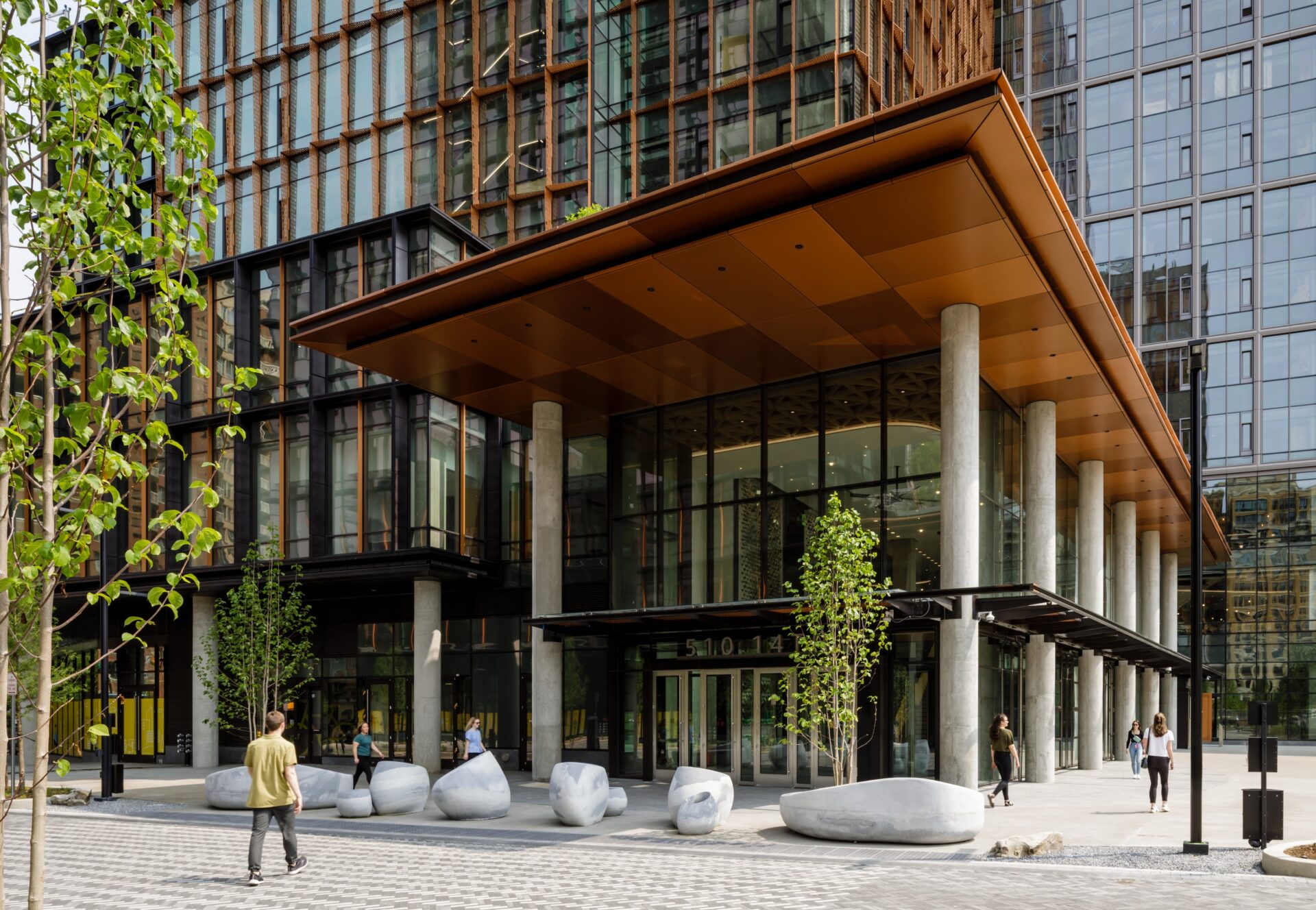
During the construction phase, 82% of all construction waste materials were diverted from landfills, compared to the statewide average of 35%. Over 17,000 tons of waste, including concrete, drywall, metals, wood, cardboard, and plastic, four times the weight of the US Capitol Dome, was recycled or repurposed, showcasing the commitment to sustainable waste management practices.
HQ2 is targeting LEED Platinum certification, which is the highest level of certification under the Leadership in Energy and Environmental Design (LEED) rating system. With its sustainable features and practices, HQ2’s Met Park is set to become the largest LEED v4 Platinum building in the United States.
——————
We’re here to help. For guidance on how we can help you achieve your sustainability goals, please contact a Seneca Group professional.
